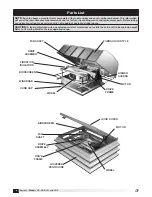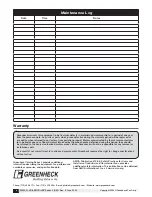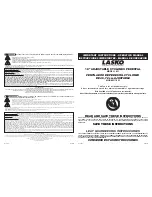
2
®
Series L: Models LB, LBP, LD, and LDP
Receiving
Upon receiving the product, check to make sure
all items are accounted for by referencing the bill
of lading to ensure all items were received. Inspect
each crate for shipping damage before accepting
delivery. Notify the carrier if any damage is noticed.
The carrier will make notification on the delivery
receipt acknowledging any damage to the product.
All damage should be noted on all the copies of the
bill of lading which is countersigned by the delivering
carrier. A Carrier Inspection Report should be filled
out by the carrier upon arrival and reported to the
Traffic Department. If damaged upon arrival, file
a claim with carrier. Any physical damage to the
unit after acceptance is not the responsibility of
Greenheck Fan Corporation.
Unpacking
Verify that all required parts and the correct quantity
of each item have been received. If any items are
missing, report shortages to your local representative
to arrange for obtaining missing parts. Sometimes it
is not possible that all items for the unit be shipped
together due to availability of transportation and
truck space. Confirmation of shipment(s) must be
limited to only items on the bill of lading.
Handling
When lifting the unit to the roof, securely fasten
straps to the drive frame located in the motor
compartment. Access to the motor compartment is
accomplished by removing bolts securing the hood
to the base. The hood cover will need to be removed
for access to the drive frame. The cover can then
be removed and placed on a flat surface in an area
protected from strong winds.
When unit is on the roof, move fan to desired location
and fasten securely through mounting holes in base.
Shims may be necessary depending upon roof
material thickness.
The motor amperage and voltage ratings must be
checked for compatibility to supply voltage prior to
final electrical connection. Electrical lead-in wires
should be run through the conduit provided between
the curb and the bottom of the motor compartment.
Wiring must conform to local and national codes.
Storage
Fans are protected against damage during shipment.
If the unit cannot be installed and operated
immediately, precautions need to be taken to prevent
deterioration of the unit during storage. The user
assumes responsibility of the fan and accessories
while in storage. The manufacturer will not be
responsible for damage during storage. These
suggestions are provided solely as a convenience to
the user.
Indoor
The ideal environment for the storage of fans and
accessories is indoors, above grade, in a low
humidity atmosphere which is sealed to prevent the
entry of blowing dust, rain or snow. Temperatures
should be evenly maintained between 30° to 110°F
(-1° to 43°C), wide temperature swings may cause
condensation and “sweating” of metal parts. All
accessories must be stored indoors in a clean, dry
atmosphere.
Remove any accumulations of dirt, water, ice, or
snow and wipe dry before moving to indoor storage.
To avoid “sweating” of metal parts allow cold parts to
reach room temperature. To dry parts and packages
use a portable electric heater to remove any moisture
build up. Leave coverings loose to permit air
circulation and to allow for periodic inspection.
The unit should be stored at least 3½ inches (89 mm)
off the floor on wooden blocks covered with moisture
proof paper or polyethylene sheathing. Aisles
between parts and along all walls should be provided
to permit air circulation and space for inspection.
Outdoor
Fans designed for outdoor applications may be
stored outdoors, if absolutely necessary. Roads or
aisles for portable cranes and hauling equipment are
needed.
The fan should be placed on a level surface to
prevent water from leaking into the fan. The fan
should be elevated on an adequate number of
wooden blocks so it is above water and snow levels
and has enough blocking to prevent it from settling
into soft ground. Locate parts far enough apart to
permit air circulation, sunlight and space for periodic
inspection. To minimize water accumulation, place all
fan parts on blocking supports so rain water will run
off.
Do not cover parts with plastic film or tarps as these
cause condensation of moisture from the air passing
through heating and cooling cycles. Fan wheels
should be blocked to prevent spinning caused by
strong winds.
Inspection and Maintenance During
Storage
While in storage, inspect fans once per month. Keep
a record of inspection and maintenance performed.
If moisture or dirt accumulations are found on parts,
the source should be located and eliminated. At each
inspection, rotate the wheel by hand ten to fifteen
revolutions to distribute lubricant on motor. If paint
deterioration begins, consideration should be given
to touch-up or repainting. Fans with special coatings
may require special techniques for touch-up or
repair.
CAUTION
Do not lift by the fan hood. Avoid lifting fans in a
way that will bend or distort fan parts. Never pass
slings or timbers through the venturi of fan. Fans
with special coatings or paints must be protected
in handling to prevent damage.


























